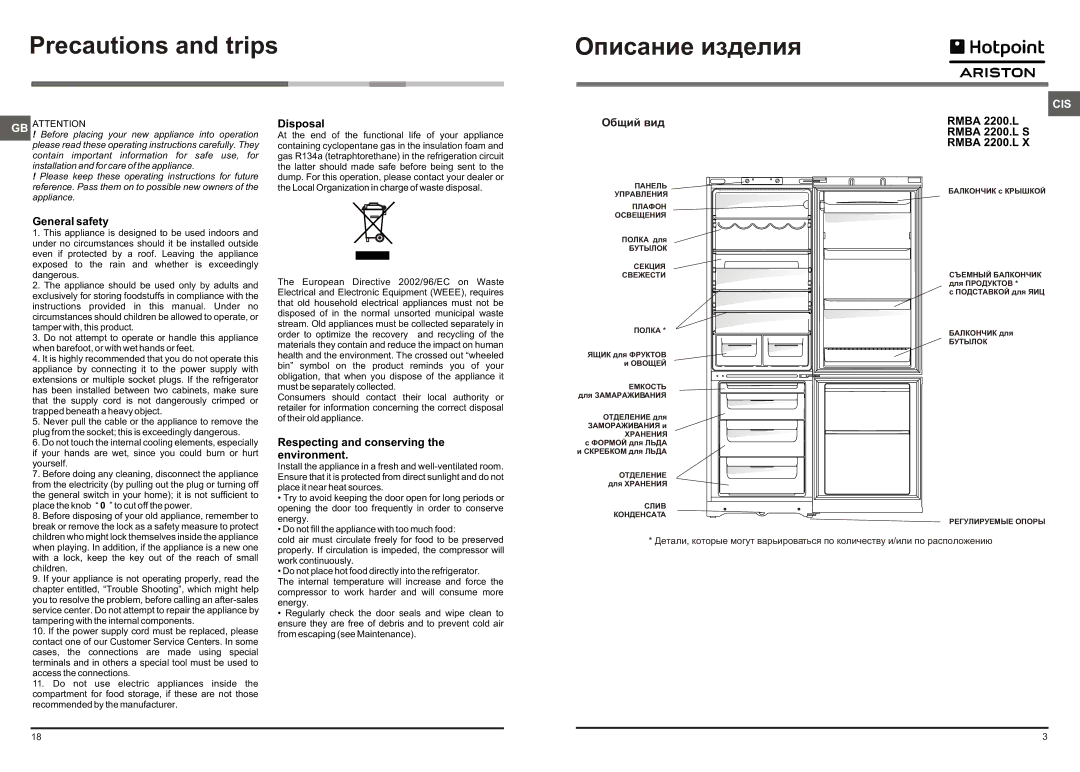
Precautions and trips
Îïèñàíèå èçäåëèÿ |
CIS |
GB ATTENTION
!Before placing your new appliance into operation please read these operating instructions carefully. They contain important information for safe use, for installation and for care of the appliance.
!Please keep these operating instructions for future reference. Pass them on to possible new owners of the appliance.
Disposal
At the end of the functional life of your appliance containing cyclopentane gas in the insulation foam and gas R134a (tetraphtorethane) in the refrigeration circuit the latter should made safe before being sent to the dump. For this operation, please contact your dealer or the Local Organization in charge of waste disposal.
Îáùèé âèä | RMBA 2200.L | |
| RMBA 2200.L S | |
| RMBA 2200.L X | |
ÏÀÍÅËÜ | ÁÀËÊÎÍ×ÈÊ ñ ÊÐÛØÊÎÉ | |
ÓÏÐÀÂËÅÍÈß | ||
| ||
ÏËÀÔÎÍ |
| |
ÎÑÂÅÙÅÍÈß |
|
General safety
1.This appliance is designed to be used indoors and under no circumstances should it be installed outside even if protected by a roof. Leaving the appliance exposed to the rain and whether is exceedingly dangerous.
2.The appliance should be used only by adults and exclusively for storing foodstuffs in compliance with the instructions provided in this manual. Under no circumstances should children be allowed to operate, or tamper with, this product.
3.Do not attempt to operate or handle this appliance when barefoot, or with wet hands or feet.
4.It is highly recommended that you do not operate this appliance by connecting it to the power supply with extensions or multiple socket plugs. If the refrigerator has been installed between two cabinets, make sure that the supply cord is not dangerously crimped or trapped beneath a heavy object.
5.Never pull the cable or the appliance to remove the plug from the socket; this is exceedingly dangerous.
6.Do not touch the internal cooling elements, especially if your hands are wet, since you could burn or hurt yourself.
7.Before doing any cleaning, disconnect the appliance from the electricity (by pulling out the plug or turning off the general switch in your home); it is not sufficient to place the knob “ 0 ” to cut off the power.
8.Before disposing of your old appliance, remember to break or remove the lock as a safety measure to protect children who might lock themselves inside the appliance when playing. In addition, if the appliance is a new one with a lock, keep the key out of the reach of small children.
9.If your appliance is not operating properly, read the chapter entitled, “Trouble Shooting”, which might help you to resolve the problem, before calling an
10.If the power supply cord must be replaced, please contact one of our Customer Service Centers. In some cases, the connections are made using special terminals and in others a special tool must be used to access the connections.
11.Do not use electric appliances inside the compartment for food storage, if these are not those recommended by the manufacturer.
The European Directive 2002/96/EC on Waste Electrical and Electronic Equipment (WEEE), requires that old household electrical appliances must not be disposed of in the normal unsorted municipal waste stream. Old appliances must be collected separately in order to optimize the recovery and recycling of the materials they contain and reduce the impact on human health and the environment. The crossed out “wheeled bin” symbol on the product reminds you of your obligation, that when you dispose of the appliance it must be separately collected.
Consumers should contact their local authority or retailer for information concerning the correct disposal of their old appliance.
Respecting and conserving the environment.
Install the appliance in a fresh and
•Try to avoid keeping the door open for long periods or opening the door too frequently in order to conserve energy.
•Do not fill the appliance with too much food:
cold air must circulate freely for food to be preserved properly. If circulation is impeded, the compressor will work continuously.
• Do not place hot food directly into the refrigerator.
The internal temperature will increase and force the compressor to work harder and will consume more energy.
•Regularly check the door seals and wipe clean to ensure they are free of debris and to prevent cold air from escaping (see Maintenance).
ÏÎËÊÀ äëÿ |
|
ÁÓÒÛËÎÊ |
|
ÑÅÊÖÈß | ÑÚÅÌÍÛÉ ÁÀËÊÎÍ×ÈÊ |
ÑÂÅÆÅÑÒÈ | |
| äëÿ ÏÐÎÄÓÊÒÎÂ * |
| ñ ÏÎÄÑÒÀÂÊÎÉ äëÿ ßÈÖ |
ÏÎËÊÀ * | ÁÀËÊÎÍ×ÈÊ äëÿ |
| ÁÓÒÛËÎÊ |
ßÙÈÊ äëÿ ÔÐÓÊÒÎÂ |
|
è ÎÂÎÙÅÉ |
|
ÅÌÊÎÑÒÜ |
|
äëÿ ÇÀÌÀÐÀÆÈÂÀÍÈß |
|
ÎÒÄÅËÅÍÈÅ äëÿ |
|
ÇÀÌÎÐÀÆÈÂÀÍÈß è |
|
ÕÐÀÍÅÍÈß |
|
c ÔÎÐÌÎÉ äëÿ ËÜÄÀ |
|
è ÑÊÐÅÁÊÎÌ äëÿ ËÜÄÀ |
|
ÎÒÄÅËÅÍÈÅ äëÿ ÕÐÀÍÅÍÈß
ÑËÈÂ
ÊÎÍÄÅÍÑÀÒÀ
ÐÅÃÓËÈÐÓÅÌÛÅ ÎÏÎÐÛ
* Äåòàëè, êîòîðûå ìîãóò âàðüèðîâàòüñÿ ïî êîëè÷åñòâó è/èëè ïî ðàñïîëîæåíèþ
18
3
